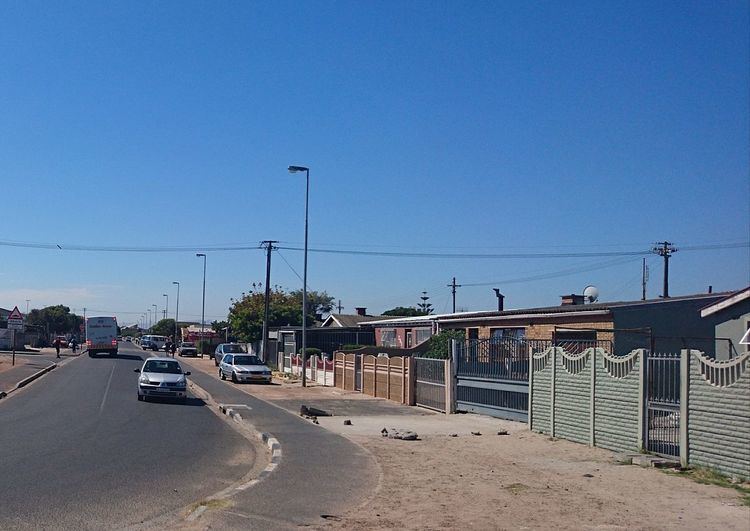Postal code (street) 7764 Local time Monday 2:11 AM | Area code 021 PO box 7764 | |
 | ||
Weather 19°C, Wind SW at 10 km/h, 70% Humidity | ||
Manenberg is a township of Cape Town, South Africa, that was created by the apartheid government for low-income Coloured families in the Cape Flats in 1966 as a result of the force removal campaign by the National Party. It has an estimated population of 52,000 residents. The area consists of rows of semi-detached houses and project-like flats, known as "korre". The township is located about 20 km away from the city centre of Cape Town. It is separated from neighbouring Nyanga and Gugulethu townships by a railway line to the east and from Hanover Park by the Sand Industria industrial park to the west and Heideveld to the north.
Contents
- Map of Manenberg Cape Town 7764 South Africa
- History
- Early activism in the 1970s and 1980s in Manenberg
- 1999 tornado
- Present day
- Popular culture
- References
Map of Manenberg, Cape Town, 7764, South Africa
History
Planning for a Coloured township to receive forcibly relocated people during the height of implementation of Group Areas Act by the apartheid government of South Africa began in 1964. Manenberg was established in 1966 with residents predominantly coming from areas designated by the apartheid government as white such as Constantia, District Six, Cape Town city centre, the Bo-Kaap, Wynberg, Crawford, Sea Point, and Lansdowne. Provision for public facilities and access to resources and jobs in the rest of the city was designed to keep residents at disadvantage relative to white areas.
The building phase of the neighbourhood lasted from 1966 to 1970 with completion of 5,621 homes for 33,922 residents at a cost of R7,386,817 (roughly equivalent to R460,000,000 in 2017). By 1975 the area consisted of about seven corner shops and two liquor outlets. There were no adequate commercial facilities or community services. A railway line from the black township of Gugulethu divides Manenberg. Nyanga Railway Station was established to service the growing population of Gugulethu and Manenberg. Later in the mid-1980s, because of housing shortages and problems around squatting in Manenberg, 364 additional buildings known as maisonettes (or as ‘infill scheme’) were built. These had three bedrooms, a living room, a kitchen, hot water, and a toilet and were regarded as better accommodation units.
Housing conditions and the basic design of area was a major grievance that prompted local residents to participate in a rage of anti-apartheid activities including acts of civil disobedience in an effort to make the country ungovernable.
Early activism in the 1970s and 1980s in Manenberg
Community activists mobilized residents in Manenberg around housing and living conditions. A citizen newspaper (named "Grassroots") was started and forming part of an alternative press movement in the 1980s. It was the first of a series of anti-apartheid community newspapers, with a circulation that grew up to 20 000 and covered community issues such as local protests.
From the national 1976 riots to the meat boycotts of 1981 to the United Democratic Front UDF and Mass Democratic Movement era of the early to late 1980s. Manenberg had activists that helped make South Africa ungovernable, many of which were trained by the African National Congress ANC in the underground movement. From the 1970s right through the 1990s, numerous community and civic movements and organisations were established.
1999 tornado
In the night of the 29th August 1999 a tornado hid the neighbourhood killing 5 people with wind speeds reaching over 150 km per hour. Over 220 people were injured and more than 5,000 residents were left homeless with 40 flats being "totally gutted". R1 million (roughtly equivelent to R2.6 million in 2017) was allocated by City of Cape Town's disaster relief fund for rebuilding.
Present day
The area over the years has become overcrowded and living conditions problematic with a high incidence of crime, gangsterism and social disturbance emerging. Graffiti exhibits portraying gangster life are prominent in Manenberg. Tupac Shakur features strongly in exhibits of the Hard Livings gang due to his rap lyrics detailing life in poverty.
